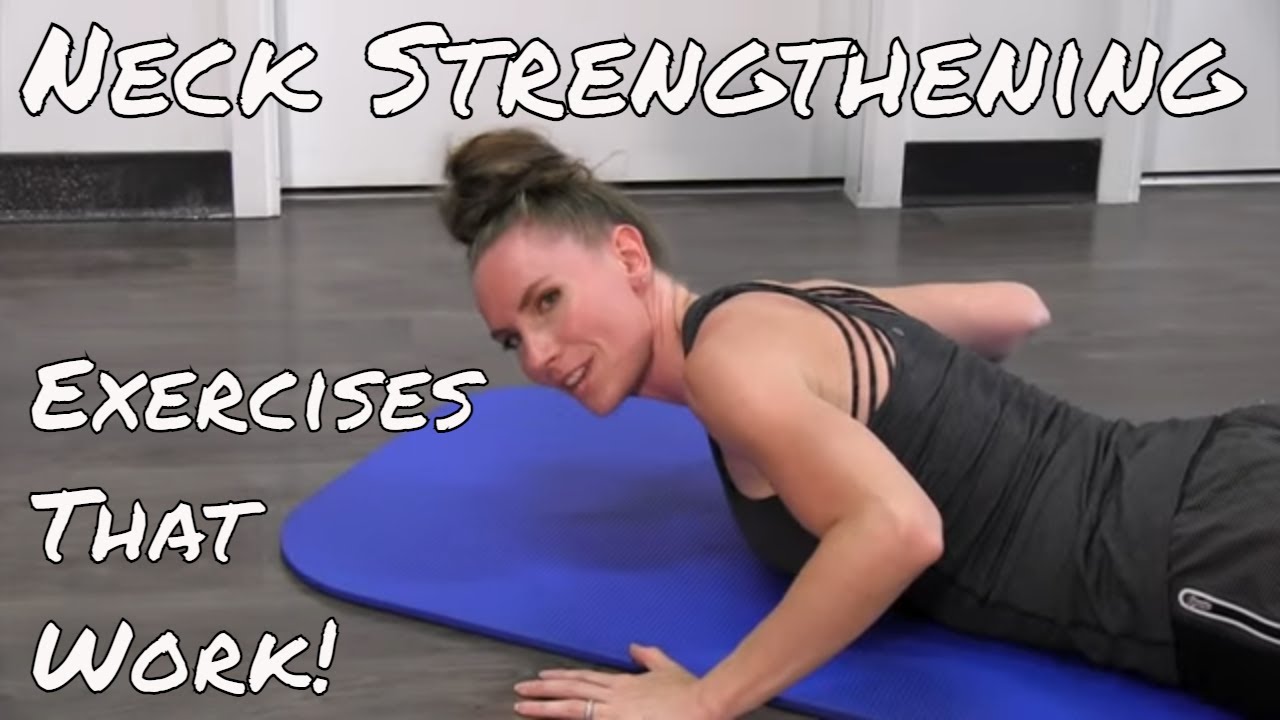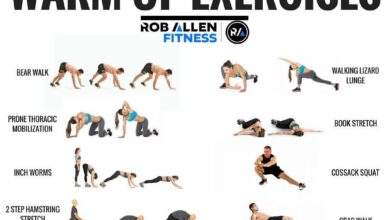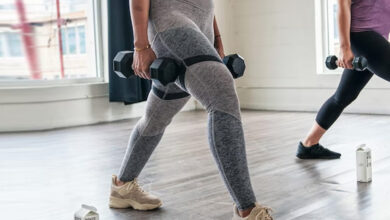
Why Your Neck Position Matters During Weight Training
Why Your Neck Position Matters During Weight Training? It might seem like a small detail, but the way you hold your head during weight training can have a big impact on your overall health and performance. Imagine lifting heavy weights, focusing on your form, and suddenly a sharp pain shoots through your neck.
This isn’t just a fleeting discomfort, it’s a sign that your neck alignment is crucial for safe and effective weight training.
This article will delve into the importance of proper neck alignment, the potential risks of improper positioning, and how to achieve and maintain a neutral neck position during various weight training exercises. We’ll explore common neck mistakes and provide exercises to strengthen your neck muscles.
By understanding these principles, you can enhance your training experience, minimize the risk of injury, and ultimately achieve your fitness goals.
The Importance of Neck Position
Your neck is a crucial part of your body, connecting your head to your spine. During weight training, maintaining proper neck alignment is vital for overall spinal health and preventing potential injuries.
The Benefits of Neutral Neck Positioning
Neutral neck positioning is the ideal posture during weight training. It involves keeping your head in a natural, upright position, aligned with your spine. This posture promotes proper spinal alignment and helps to distribute weight evenly across your body.
- Reduced Strain on the Neck and Spine:Neutral neck positioning minimizes strain on the neck muscles and ligaments, preventing discomfort and potential injuries.
- Improved Breathing:When your neck is in a neutral position, your airway remains open, allowing for optimal breathing during exercise.
- Enhanced Performance:A neutral neck posture helps to maintain proper balance and coordination, contributing to better performance during exercises.
Risks of Improper Neck Positioning
Improper neck positioning during weight training can lead to various problems, including strain, injury, and discomfort.
You might think that focusing on proper form during weight training is all about your muscles, but your neck position is crucial too. It’s not just about preventing injury, but also about managing stress. Tension in your neck can contribute to anxiety, and if you’re already struggling with common types of anxiety and how to cope , the last thing you need is an extra layer of stress from improper lifting.
So, take a moment to relax your neck, engage your core, and focus on controlled movements. You’ll be surprised how much better your lifts feel, and how much calmer you’ll feel overall.
- Neck Strain and Pain:Tilting your head forward or backward can strain the neck muscles, leading to pain and discomfort.
- Headaches:Improper neck positioning can compress nerves and blood vessels in the neck, contributing to headaches.
- Risk of Injury:Excessive neck flexion or extension can increase the risk of injuries, such as whiplash or disc herniation.
Comparing Neutral Neck Positioning to Other Postures
While neutral neck positioning is the recommended posture during weight training, other postures, such as tilting or flexing the neck, can be detrimental.
- Tilting the Neck:Tilting your head forward or backward puts undue stress on the neck muscles and ligaments, increasing the risk of strain and pain.
- Flexing the Neck:Flexing your neck, such as when looking down at the ground, can compress the spinal cord and nerves, leading to pain and numbness.
Neutral Neck Alignment
Maintaining a neutral neck position during weight training is crucial for preventing injuries and optimizing performance. It ensures that your head is balanced atop your spine, minimizing strain on your neck muscles and joints.
A neutral spine is crucial during weight training, especially when it comes to your neck. Keeping your head in line with your spine prevents strain and injury. It’s like how shifting your self-talk around food can help you create a healthier relationship with eating – it’s all about finding a balanced and supportive approach.
Learn more about positive ways to shift your self-talk around food for a healthier perspective. Just as a neutral spine is vital for your neck during training, a positive mindset is essential for your overall well-being. So, remember to keep your neck aligned and your thoughts positive for a healthier and more fulfilling journey.
Understanding Neutral Neck Alignment
Neutral neck alignment refers to the natural curvature of your cervical spine, the uppermost part of your spinal column. In this position, your ears are aligned with your shoulders, and your chin is slightly tucked in, creating a gentle curve in your neck.
- Anatomical Landmarks:
- Ear Lobes:Should align vertically with your shoulders when viewed from the side.
- Chin:Should be slightly tucked in, creating a slight double chin, and not jutting forward.
- Cervical Spine:Should have a natural curve, not straight or excessively arched.
- Benefits of Neutral Neck Alignment:
- Reduced Risk of Neck Pain:By maintaining a neutral position, you minimize stress on the cervical spine and surrounding muscles.
- Improved Posture:Proper neck alignment contributes to overall good posture, enhancing balance and stability.
- Enhanced Performance:A stable neck allows for efficient force transfer during exercises, maximizing your strength potential.
Maintaining Neutral Neck Alignment During Weight Training
Maintaining a neutral neck alignment during weight training requires conscious effort and attention to proper form. Here are some practical tips:
- Engage Your Core:A strong core helps stabilize your spine, including your neck. Actively engage your abdominal muscles throughout your exercises.
- Keep Your Chin Tucked:Avoid letting your chin jut forward or tilting your head back. A slight double chin is a good indicator of proper alignment.
- Avoid Excessive Head Movements:Minimize unnecessary head movement during exercises. Keep your head still and aligned with your spine.
- Use a Spotter:If you’re lifting heavy weights, consider using a spotter to assist with maintaining proper form and ensure safety.
Illustrative Examples of Neutral Neck Alignment During Weight Training
- Squats:Imagine a straight line extending from your head to your heels. Your ears should be aligned with your shoulders throughout the movement.
- Correct Posture:The head is held straight, ears aligned with shoulders, chin slightly tucked in. The back is straight, and the core is engaged.
- Incorrect Posture:The head is tilted back, ears are not aligned with shoulders, and the chin is jutting forward. The back is rounded, and the core is not engaged.
- Deadlifts:Keep your neck neutral throughout the lift. Avoid looking up or tilting your head back.
- Correct Posture:The head is held straight, ears aligned with shoulders, chin slightly tucked in. The back is straight, and the core is engaged.
- Incorrect Posture:The head is tilted back, ears are not aligned with shoulders, and the chin is jutting forward.
The back is rounded, and the core is not engaged.
- Bench Press:Your head should be resting on the bench, maintaining a neutral spine. Avoid tilting your head up or down.
- Correct Posture:The head is resting on the bench, ears aligned with shoulders, chin slightly tucked in. The back is flat on the bench, and the core is engaged.
- Incorrect Posture:The head is lifted off the bench, ears are not aligned with shoulders, and the chin is jutting forward. The back is arched, and the core is not engaged.
Common Neck Mistakes
It’s easy to get caught up in the intensity of weight training and forget about the importance of proper form, especially when it comes to your neck. Neglecting neck positioning during exercises can lead to serious injuries, hindering your progress and potentially causing long-term pain.
Keeping your neck in a neutral position during weight training is crucial for preventing injury and maximizing performance. Just like a good workout routine, staying consistent with your meal prep is key to achieving your fitness goals. If you’re feeling stuck in a rut, check out these 6 proven ways to get out of a meal prep plateau to reignite your motivation.
Once you’ve got your nutrition dialed in, you can focus on proper form and technique, ensuring your neck remains aligned with your spine for a safe and effective workout.
Here are some common mistakes and how to avoid them:
Neck Extension
Neck extension occurs when you tilt your head backward, straining the muscles in the back of your neck. This can happen during exercises like bench press, shoulder press, and deadlifts.
- Risks:Neck extension can put excessive pressure on the cervical spine, leading to muscle strains, ligament tears, and even herniated discs. It can also cause headaches and dizziness.
- Solutions:Focus on keeping your head in a neutral position, with your chin slightly tucked towards your chest. Imagine a straight line running from your ears to your shoulders. During exercises, avoid arching your back, as this can lead to neck extension.
Neck Flexion
Neck flexion happens when you tilt your head forward, putting pressure on the front of your neck. This can occur during exercises like squats, lunges, and rows.
- Risks:Neck flexion can strain the muscles in the front of your neck, leading to pain, stiffness, and even pinched nerves. It can also contribute to headaches and neck pain.
- Solutions:Maintain a neutral head position throughout the exercise, keeping your chin slightly tucked. Avoid looking down or tilting your head forward. Focus on engaging your core to maintain a stable spine, which will help prevent excessive neck flexion.
Neck Rotation
Neck rotation involves turning your head to the side, which can strain the muscles and ligaments in your neck. This can occur during exercises like dumbbell rows, bicep curls, and triceps extensions.
- Risks:Neck rotation can lead to muscle strains, ligament tears, and even whiplash. It can also cause headaches, dizziness, and pain in the shoulders and upper back.
- Solutions:Keep your head facing forward throughout the exercise. Avoid turning your head to the side, even if it feels more comfortable. If you find yourself naturally rotating your head, try using a mirror to monitor your form and make adjustments as needed.
Exercises for Neck Strengthening: Why Your Neck Position Matters During Weight Training
A strong neck is crucial for maintaining proper posture, reducing the risk of injury, and enhancing athletic performance. By strengthening the muscles that support the neck and upper back, you can improve your overall stability and resilience during weight training and other activities.
Neck Flexion and Extension
Neck flexion and extension exercises target the muscles responsible for moving your head forward and backward.
- Neck Flexion:Sit or stand with your back straight and shoulders relaxed. Slowly nod your head forward, bringing your chin towards your chest. Hold for a few seconds, then slowly return to the starting position. Repeat 10-15 times.
- Neck Extension:Sit or stand with your back straight and shoulders relaxed. Slowly tilt your head backward, bringing your chin towards your chest. Hold for a few seconds, then slowly return to the starting position. Repeat 10-15 times.
Neck Rotation
Neck rotation exercises target the muscles responsible for turning your head from side to side.
- Neck Rotation:Sit or stand with your back straight and shoulders relaxed. Slowly rotate your head to the right, keeping your chin level. Hold for a few seconds, then slowly return to the starting position. Repeat 10-15 times on each side.
Neck Lateral Flexion
Neck lateral flexion exercises target the muscles responsible for tilting your head to the side.
- Neck Lateral Flexion:Sit or stand with your back straight and shoulders relaxed. Slowly tilt your head to the right, bringing your ear towards your shoulder. Hold for a few seconds, then slowly return to the starting position. Repeat 10-15 times on each side.
Isometric Neck Holds
Isometric neck holds engage the muscles without any movement, helping to build strength and stability.
- Isometric Neck Hold:Sit or stand with your back straight and shoulders relaxed. Place your hand on your forehead and gently push your head forward against your hand. Hold for 5-10 seconds, then relax. Repeat 10-15 times. You can also perform this exercise by placing your hand on the back of your head and gently pushing your head backward.
Resistance Band Neck Exercises
Resistance bands can add resistance to neck exercises, further challenging the muscles and promoting strength gains.
- Resistance Band Neck Flexion:Secure a resistance band around your head, just above your forehead. Hold the ends of the band with your hands, keeping your elbows close to your sides. Slowly nod your head forward, pulling the band with your hands.
Hold for a few seconds, then slowly return to the starting position. Repeat 10-15 times.
- Resistance Band Neck Extension:Secure a resistance band around your head, just below your chin. Hold the ends of the band with your hands, keeping your elbows close to your sides. Slowly tilt your head backward, pulling the band with your hands. Hold for a few seconds, then slowly return to the starting position.
Repeat 10-15 times.
- Resistance Band Neck Rotation:Secure a resistance band around your head, just above your ears. Hold the ends of the band with your hands, keeping your elbows close to your sides. Slowly rotate your head to the right, pulling the band with your hands.
Hold for a few seconds, then slowly return to the starting position. Repeat 10-15 times on each side.
- Resistance Band Neck Lateral Flexion:Secure a resistance band around your head, just above your ears. Hold the ends of the band with your hands, keeping your elbows close to your sides. Slowly tilt your head to the right, pulling the band with your hands.
Hold for a few seconds, then slowly return to the starting position. Repeat 10-15 times on each side.
Wall Slides
Wall slides are a great way to strengthen the muscles in your upper back, which play a crucial role in supporting your neck.
- Wall Slides:Stand facing a wall with your feet shoulder-width apart and your back flat against the wall. Slowly slide your arms up the wall, keeping your elbows straight and your back flat. Hold for a few seconds, then slowly slide your arms back down.
Repeat 10-15 times.
Scapular Retractions
Scapular retractions target the muscles that pull your shoulder blades together, improving posture and neck stability.
- Scapular Retractions:Sit or stand with your back straight and shoulders relaxed. Squeeze your shoulder blades together, as if you were trying to touch them. Hold for a few seconds, then slowly relax. Repeat 10-15 times.
Chin Tucks
Chin tucks are a simple yet effective exercise for strengthening the muscles that support your neck.
- Chin Tucks:Sit or stand with your back straight and shoulders relaxed. Gently tuck your chin towards your chest, as if you were trying to make a double chin. Hold for a few seconds, then slowly return to the starting position.
Repeat 10-15 times.
Important Considerations
- Listen to Your Body:If you experience any pain or discomfort, stop the exercise immediately.
- Start Slowly:Begin with a few repetitions and sets, gradually increasing the intensity as your neck strength improves.
- Focus on Form:Proper form is crucial for maximizing the benefits of these exercises and minimizing the risk of injury.
- Consult a Professional:If you have any concerns or underlying neck conditions, consult with a physical therapist or other qualified healthcare professional before starting any new exercise program.
Tips for Maintaining Proper Neck Position

Maintaining proper neck alignment during weight training is crucial for preventing injuries and maximizing performance. This involves actively engaging your neck muscles to keep your head in a neutral position, avoiding excessive tilting, rotation, or extension. By implementing these tips, you can ensure your neck stays protected while you lift.
Warm-up Exercises
A proper warm-up prepares your body for the demands of weight training, including your neck muscles. It increases blood flow and flexibility, reducing the risk of strain and injury.
- Neck Rotations:Slowly rotate your head from side to side, focusing on controlled movements. Aim for 10-15 repetitions in each direction.
- Neck Tilts:Gently tilt your head forward and backward, ensuring your chin remains tucked in. Perform 10-15 repetitions in each direction.
- Neck Flexions:Bring your ear towards your shoulder, keeping your head aligned with your spine. Hold for a few seconds and repeat on the other side. Perform 10-15 repetitions on each side.
Proper Breathing Techniques
Breathing plays a vital role in maintaining proper neck alignment. Holding your breath during heavy lifts can increase pressure on your neck and potentially lead to injury.
- Exhale on Exertion:Exhale during the most challenging part of the lift, such as the concentric phase (lifting the weight). This helps stabilize your core and reduce strain on your neck.
- Inhale on Release:Inhale as you lower the weight back to the starting position. This allows your body to recover and prepares you for the next repetition.
Seeking Professional Assistance, Why your neck position matters during weight training
If you have any pre-existing neck conditions or concerns about your neck alignment, it’s crucial to seek professional guidance. A qualified trainer or physical therapist can assess your posture, identify any potential issues, and provide personalized advice and exercises.
- Posture Evaluation:A professional can assess your posture and identify any imbalances or misalignments that could affect your neck position during weight training.
- Customized Exercise Program:Based on your individual needs and goals, a trainer or therapist can develop a tailored exercise program that promotes proper neck alignment and strengthens supporting muscles.
Ending Remarks
So, remember, proper neck position isn’t just about avoiding pain; it’s about maximizing your potential and achieving long-term success in your weight training journey. Pay attention to your neck alignment, practice good form, and don’t hesitate to seek guidance from a qualified professional.
By prioritizing your neck health, you’re investing in a stronger, healthier, and more sustainable fitness experience.






